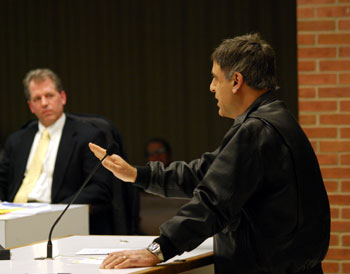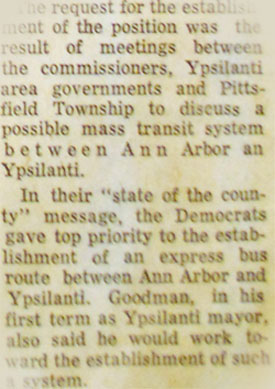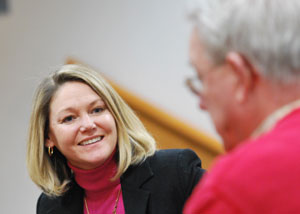Aboard 12B bus headed west, a rider asked for directions to Kroger; four different but friendly responses from passengers.
Stories indexed with the term ‘bus’
Main & Oakbrook
Aboard AAATA #7 bus headed back to downtown a few minutes behind schedule, driver calls ahead to Blake Transit Center to hold #12 bus for passenger who needs to make that connection.
Column: Chevy Volt – Private Transit Choices
Last week The Chronicle received a cold-call from Suburban Chevrolet out at Wagner and Jackson roads with an offer to test-drive a Chevy Volt.

Even if you don't know me, this photo is a dead give-away that I am not a car guy. I deliberately shot that photo from an angle that would include Suburban Chevrolet's sign in the background, And I thought I'd nailed it – because the sign said "Suburban." (Photos by the writer.)
The sales consultant was keen to point out that Suburban Chevrolet was the first area dealership to have a vehicle available for test drives. But test-driving a car is pretty remote from The Chronicle’s mission, and even more remote from my personal transportation choice.
I share a membership in Zipcar with my wife, but don’t even remember the last time I’ve sat behind the wheel of a car myself. Zipcar, a car-sharing service, is like an insurance policy – a backup plan I never use. I get around by bicycle.
Still, in the Chevy Volt, I spotted a chance to write about a major public works construction project in downtown Ann Arbor – the Fifth Avenue underground parking structure, which will feature around 640 parking spaces on a lot that previously offered 192 spots.
Twenty-two of those new spots will be equipped with electric car charging stations. Dave Konkle, former energy coordinator for the city of Ann Arbor who now consults for the Ann Arbor Downtown Development Authority on its energy projects, identified the federal grant that’s helping to pay for the stations. The grant is worth $264,100 and will also pay for photovoltaic panels that will provide the energy for two of the spots – it was obtained through the Clean Energy Coalition’s Clean Cities Program.
That public project is closely tied to the assumption that visitors to downtown Ann Arbor will continue to make a personal choice for private transportation in the form of an automobile, and that some of those people will choose electric cars like the Volt.
The idea I want to think about in this column is that public choices depend on the sum of many private, independent choices made by actual people. It’s an idea that was driven home to me at a public transportation forum hosted earlier this week by the Ann Arbor Transportation Authority at SPARK East in Ypsilanti.
At that forum, Bob Van Bemmelen – recent Republican candidate for the Washtenaw County board of commissioners – had this advice for the AATA as it pitches to the public the idea of countywide public transit: You have to make it personal, he said.
So I’ll begin by telling you a little bit more about the Suburban Chevrolet sales guy who gave me a ride in the Chevy Volt – who is as much a car guy as I am a bicycle guy: Nic Allebrodt. [Full Story]
Council Talks Transportation, Budget
Ann Arbor City Council meeting (Feb. 1, 2010) Part I: Transportation was a major theme woven throughout Monday’s city council meeting – in part due to a presentation the council heard from SEMCOG’s Carmine Polombo about the Detroit-Ann Arbor commuter rail project. Trains are supposed to begin rolling toward the end of 2010, but Polombo’s presentation made clear that early service would be very limited – day trips and special events – and there are a huge number of unknowns.

Sol Castell was asked to the podium by Stephen Kunselman (Ward 3) to give an alternate view on the need for a runway extension at the Ann Arbor municipal airport. The topic came up during discussion of the city's capital improvements plan, which wound up being postponed. (Photos by the writer.)
But trains weren’t the only transit-related thread. The city’s bicycle ordinances were updated after having been postponed for a couple of meetings, and a revision to the city’s bicycle registration procedure was tabled and now appears to be on indefinite hold.
The council also approved on first reading a revision to its taxicab ordinance, designed to enforce expectations of larger cab companies.
Also related to transportation was discussion of an item in the capital improvements plan (CIP) for a runway extension at the Ann Arbor municipal airport. After Stephen Kunselman (Ward 3) got his colleagues’ support to amend the CIP to delete the item, the council then voted, with some grumbles of dissent, to postpone consideration of the CIP.
Times and dates for upcoming meetings on the budget were also reviewed, with city administrator Roger Fraser telling councilmembers that the list of possible areas for cuts that city staff had generated were not the only items that could be considered. He challenged councilmembers to come up with their own ideas as well. The council received specific recommendations for budget strategies for the senior center and Mack Pool.
In Part I of the report, we restrict our focus to transportation and budget issues. In Part II, we’ll cover land use issues – including the resolution on 415 W. Washington, which we previewed in our report on the Sunday night caucus, plus a postponement on a greenbelt acquisition. [Full Story]
Federal Money May Save Bus #5 for Ypsi

A clipping from the April 3, 1973 Ann Arbor News newspaper. Headline was: "Bus System Linking City With Ypsilanti Gets Push"
At a meeting of the Ann Arbor Transportation Authority’s planning and development committee on Wednesday evening – attended by some members of Ypsilanti’s city council, plus the mayor – the possible elimination of Ypsilanti’s bus Route #5 became far less likely.
The committee recommended that federal stimulus money be used to cover a shortfall between the amount that Ypsilanti’s city council allocated to transportation, and the cost of the city’s purchase of service agreement (POSA) with the AATA through June 2011. If the recommendation to use federal dollars is approved by the full AATA board at its Sept.23 meeting, the elimination of Route #5, plus reductions in service on Routes #10 and #11, would not be necessary.
On Sept. 8, Ypsilanti’s city council had voted 5-1 (with dissent from Mayor Paul Schreiber) to propose the service reductions – chosen from a “menu” of options provided by the AATA. The Ypsilanti council resolution also included a request that the POSA rate not increase, and that about $100,000 in federal stimulus dollars – part of a $6.45 million grant to the AATA – be used to make up the remaining difference.
The willingness of the AATA’s planning and development committee to increase the federal dollars allotted to around $200,000 was based on a key condition, which is actually built into the language of the Ypsilanti council resolution: either there will be progress towards a dedicated countywide funding mechanism for mass transportation, or else the city of Ypsilanti will put a millage proposal (a Headlee override) on the November 2010 ballot. [Full Story]
First Public Meeting on Bus Fare Proposal

AATA's manager of community relations, Mary Stasiak, talks with a frequent passenger on route No. 2.
On Tuesday afternoon, representatives of the Ann Arbor Transportation Authority were on hand at the downtown branch of the Ann Arbor District Library to meet with members of the public to talk about a proposed fare increase. The AATA board will likely consider the proposal at its March 18 meeting. If passed by the AATA board, the first phase of the two-phase plan would take effect in May 2009, raising the basic fare from $1 to $1.25. In May 2010, it would climb another 25 cents to $1.50 [details on the proposed fare increases].
The lower level multipurpose room at the library can accommodate more than a hundred people, but in the course of the two-hour meeting, only around ten members of the public stopped by – some arriving well after the meeting started, and some leaving somewhere in the middle. In that regard, the meeting was like a public bus: it left the station at its scheduled time with some passengers, took additional riders on board along the way, and let some of them off before the route was finished. But one could ask the same question about the meeting that is frequently asked about the bus system: Why does the AATA run some buses that appear to be mostly empty? [Full Story]



